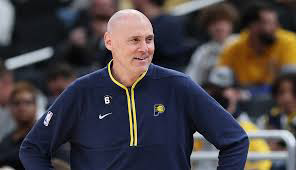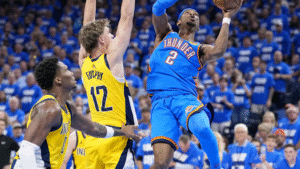
Indiana Pacers Face a Transition Year After NBA Finals Heartbreak, Haliburton’s Injury, and Roster Changes—But Johnny Furphy Offers a Glimmer of Hope
The Indiana Pacers entered the 2025 NBA Finals with high expectations, dreaming of championship glory after a hard-fought playoff run. But everything changed in the blink of an eye when Tyrese Haliburton, their superstar floor general and two-time All-NBA point guard, collapsed with a severe injury early in Game 7 of the Finals against the Oklahoma City Thunder. The entire energy of the team seemed to drain out in that moment.

Haliburton’s injury was devastating—not only emotionally, but practically. The team was built around his ability to lead the offense, and without him, Indiana looked out of sorts. The offense stagnated, defensive matchups were lost, and Oklahoma City took full advantage. By the final buzzer, the Thunder were celebrating their championship win, while the Pacers were left to reflect on what might have been. As it stands, Indiana’s short-term hopes for a title have dimmed significantly.
And the challenges didn’t end with that Finals loss. Shortly after the heartbreaking defeat, it was announced that Haliburton’s injury was severe enough to rule him out for the entirety of the 2025-26 season. That news hit the Pacers hard. Losing Haliburton is like taking the engine out of a finely tuned sports car—the entire system has to be reevaluated.
As if that weren’t enough, the Pacers will also begin the new season without one of their cornerstone veterans, center Myles Turner. The defensive anchor and veteran leader opted to leave Indiana in free agency, signing with another team in search of a new challenge and perhaps a better shot at a ring. Turner’s decision means Indiana has lost both their offensive and defensive leaders in one offseason.
Still, despite these seismic shifts, Indiana’s front office is not throwing in the towel. General manager Chad Buchanan recently joined Alex Golden and co-host Facci on the podcast “Setting The Pace: A Pacers Podcast” to discuss where the team stands and how they plan to move forward during what many are calling a “gap year.”
Buchanan didn’t sugarcoat the team’s situation. He acknowledged that the roster is in transition, and that expectations from the outside world will undoubtedly be lowered. Yet he emphasized that the Pacers still have goals and internal standards to meet. They may not be favorites to make a deep playoff run in 2026, but that doesn’t mean the season will be without purpose or potential.
One of the players who Buchanan is especially hopeful about is Johnny Furphy, a 20-year-old Australian shooting guard entering his second season in the NBA. While Furphy’s rookie year didn’t feature many highlights—he averaged just 2.1 points per game in limited minutes—he’s already showing signs of turning a corner.
According to Buchanan, Furphy has demonstrated significant development since the end of the NBA Finals. The team barely had time to rest before heading into Summer League play in Las Vegas, and Furphy made the most of the opportunity. In just three games, he averaged 11.3 points on a much-improved shooting percentage from the field (.520), along with 4.0 rebounds, 1.0 steals, and nearly a block per game.
What impressed Buchanan the most wasn’t just the numbers, but how Furphy carried himself on the court. He spoke of Furphy’s growth in several areas—his physical conditioning, his confidence, and most importantly, his aggressiveness. There’s a marked difference in Furphy’s approach, especially compared to the previous summer when he was still finding his footing in the league.
“He’s made strides across the board,” Buchanan said. “Last year’s Summer League version of Johnny looks nothing like the one we just saw. His body’s stronger, he’s more confident in attacking, and you can see the intent when he drives to the basket. He’s not afraid to take it into the paint, even when there are defenders in his way.”
Buchanan also highlighted Furphy’s potential as a unique weapon in the Pacers’ offense—especially in a Haliburton-less system. Furphy thrives when cutting off the ball, running the floor in transition, and catching the ball on the move to finish at the rim. His energy and athleticism create opportunities for others and force defensive rotations that can open up Indiana’s shooters.
However, Buchanan made it clear that Furphy’s path to becoming a regular contributor will hinge heavily on one particular skill: shooting. While Furphy shot over 50% from the field during Summer League, his three-point percentage (.250) was far from ideal. The Pacers believe that if he can boost that outside shot into the high-30% range—especially in catch-and-shoot situations—he can carve out a consistent spot in the team’s rotation.
“If Johnny becomes a reliable three-point shooter, we’ve got something really special,” Buchanan said. “He’s already got an edge in athleticism and size compared to someone like Ben Sheppard, who’s carved out a decent role for himself. If Furphy can match that shot-making ability, he brings even more to the table in terms of versatility.”
Sheppard, who is also entering his third season, saw more playing time than Furphy last year. He posted averages of 5.3 points, 2.8 rebounds, and 1.3 assists in just under 20 minutes per game. His shooting percentages were solid—42% from the field and 34% from beyond the arc—but Buchanan thinks Furphy has the tools to surpass that level of impact, given his frame (6-foot-8) and natural athletic gifts.
Defense is another area where Furphy has surprised the coaching staff. Opposing teams have tried to target him, seeing the young guard as a potential weak spot. But Buchanan pointed out that Furphy has shown strong defensive instincts and agility, often holding his own in one-on-one situations. He’s been effective at keeping his man in front, contesting shots, and providing help defense when needed.
“I think a lot of guys look at Johnny and think, ‘He’s the rookie, let’s go at him,’” Buchanan said. “But he’s a tougher defender than they realize. He’s got good footwork, he plays angles well, and he doesn’t get rattled. He might not have the experience yet, but he has the mentality.”
Buchanan also praised Furphy for his hustle and coachability. Those traits, he noted, tend to win points with head coach Rick Carlisle, who values effort and focus as much as raw skill. According to Buchanan, Furphy has already earned Carlisle’s trust, and he expects the young Australian to receive more chances as the season progresses.
“Johnny’s not the kind of guy who’s going to coast through games. He’s always locked in, always playing with effort,” Buchanan said. “That matters to our coaching staff. As the year goes on and he gets more comfortable, I think you’ll see his minutes increase.”
In many ways, Furphy embodies what this next phase of the Pacers’ development will be about—youth, growth, and resilience. With Haliburton sidelined and Turner gone, Indiana has no choice but to lean on their younger players to fill the gaps. While that means growing pains are inevitable, it also means opportunity—for players like Furphy, Sheppard, and others looking to take the next step.
Buchanan acknowledged that this won’t be a championship-caliber season for the Pacers. But he also pushed back against the idea that the year is a “waste.” For Indiana, it’s a chance to retool, evaluate talent, and build internal chemistry that could pay dividends when Haliburton returns in 2026-27.
And in that context, Johnny Furphy might not just be a nice story about a young player finding his way. He might be a crucial part of the Pacers’ future.
“We believe in Johnny,” Buchanan said. “Whether it’s this year or next, he’s going to be a rotation player for us. He’s earned that belief with the way he’s developed, and we’re excited to see where he takes it from here.”
The Pacers may be entering the 2025-26 season with tempered expectations, but that doesn’t mean it’s a season without significance. For players like Furphy, it could be the year everything changes—for themselves, and for the team’s long-term trajectory.
Leave a Reply